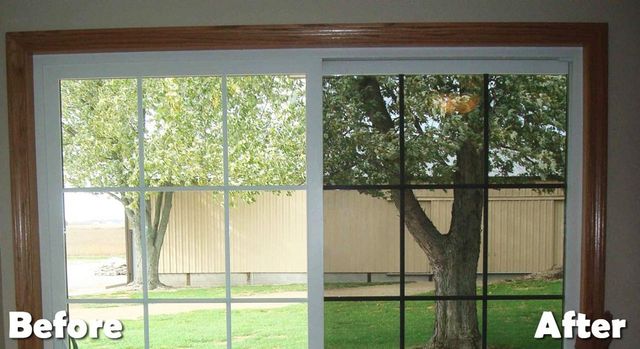Residential Window Tint: Keep Your Home Cool in the Summer Heat
Residential Window Tint: Keep Your Home Cool in the Summer Heat
Blog Article
How Residential Window Tinting Enhances Your Home's Power Effectiveness
Residential home window tinting presents a compelling option for home owners seeking to improve energy performance within their space. By applying specialized films to home windows, it successfully reduces warm transfer, consequently maintaining indoor temperatures and minimizing the need for too much home heating or air conditioning. This not just stops energy usage but also offers a more comfortable atmosphere by mitigating glare. Recognizing the subtleties of exactly how tinting works and selecting the suitable kind for your home can be critical. Oddly, what variables should one consider before making this financial investment?
Understanding Window Tinting
Understanding home window tinting is crucial for home owners looking for to enhance both comfort and power efficiency in their living areas. Residential Window Tint. Window tinting involves the application of a slim movie to the interior or exterior surface area of glass windows. This film can dramatically modulate the quantity of sunlight and heat that goes into a home, hence influencing interior climate conditions
There are different kinds of window tinting movies available, each with unique properties. The efficiency of window tinting is often measured by its Visible Light Transmission (VLT) percentage, which indicates exactly how much light can pass via the movie.
Advantages of Power Effectiveness
Home window tinting not just improves appearances however likewise plays a substantial role in enhancing energy performance within residential spaces. By minimizing warm transfer through home windows, colored films develop an extra steady interior environment, which can lead to significant reductions in power intake for home heating and air conditioning. This energy efficiency converts right into lower utility expenses, providing property owners with significant lasting financial savings.

In addition, window tinting enhances the convenience of living rooms. By minimizing glare and blocking unsafe UV rays, colored home windows produce a more pleasurable environment, which can cause enhanced wellness for residents. The protection against UV rays also helps protect furniture and floor covering from fading, adding to the durability of household products.
Exactly How Tinting Functions
Tinting films operate via a mix of sophisticated products and technologies designed to manage the quantity of solar power getting in a home. Primarily made up of polyester, these movies typically integrate metal or ceramic fragments that soak up and reflect warm. This twin capacity permits them to significantly minimize the infiltration of ultraviolet (UV) rays and infrared radiation while allowing visible light to pass through.
The performance of home window tinting is determined by its solar warm gain coefficient (SHGC), which shows just how much solar power is transmitted via the home window. Reduced SHGC values are more suitable as they denote better warmth being rejected. Furthermore, home window tints can feature a range of tones, allowing house owners to customize their visual choices while improving energy effectiveness.
Additionally, these movies function as an obstacle, avoiding warmth loss throughout colder months by he has a good point mirroring indoor heat back into the living room. This thermal insulation impact complements the air conditioning benefits obtained during warmer months, contributing to a well balanced interior climate year-round. By managing solar power successfully, household home window tinting not just enhances convenience yet also plays a vital role in decreasing power consumption and lowering utility bills.
Choosing the Right Tint

There are numerous types of window films readily available, including colored, metalized, and ceramic. Ceramic movies offer outstanding warm control without endangering exposure and are highly durable, making them a prominent choice.
Visible light transmission (VLT) is another essential factor, as it suggests the amount of natural light that can discover this info here go through the tinted glass. Homeowners ought to select a color with a VLT that complements their lighting choices while still offering adequate glare reduction.
Additionally, examining the solar heat gain coefficient (SHGC) can help determine just how well a tint can block warm from sunshine. A reduced SHGC shows far better warmth control, ultimately boosting energy effectiveness.
Installment and Maintenance Tips
Proper setup and upkeep are vital elements in making best use of the benefits of residential home window tinting. Experts likewise use specialized tools and strategies, which can improve the resilience and efficiency of the color.
Adhering to installment, maintenance is necessary to prolong the life of the home window movie. It is suggested to wait at the very least 30 days before cleaning up the tinted windows to permit the adhesive to cure totally.
Resolving these problems immediately can stop more damage and preserve energy performance. By adhering to these installment and maintenance pointers, home owners can ensure their window tinting proceeds to supply substantial power savings and comfort for years to come.
Verdict
In final thought, property window tinting offers as a reliable option for improving power performance within homes. By decreasing heat transfer and blocking damaging UV rays, home window films contribute to reduce power usage and improved interior comfort.
Window tinting includes the application of a thin film to the inside or exterior surface of glass windows. By reducing warm transfer with windows, colored movies create a more find more information steady indoor climate, which can lead to substantial reductions in power consumption for home heating and air conditioning.The efficiency of home window tinting is measured by its solar heat gain coefficient (SHGC), which shows just how much solar energy is transmitted through the window. By handling solar power efficiently, household home window tinting not just improves comfort however likewise plays an essential role in reducing power intake and reducing utility bills.
By minimizing warm transfer and blocking harmful UV rays, window movies contribute to decrease energy consumption and improved indoor convenience.
Report this page